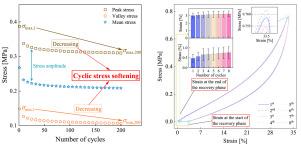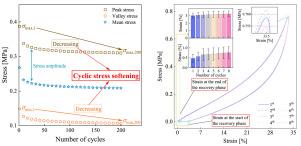Experimental characterization of cyclic stress softening for isotropic soft magnetorheological elastomer
IF 4.5
2区 化学
Q2 POLYMER SCIENCE
引用次数: 0
Abstract
Soft magnetorheological elastomer (s-MRE) is fabricated by dispersing magnetic particles within the elastomer matrix. Its mechanical properties dramatically change under the applied magnetic field, exhibiting a typical magnetorheological (MR) effect. This property provides s-MRE with the potential for application in vibration control. During vibration control application scenarios, s-MRE-based vibration control devices are often subjected to asymmetric cyclic loads, for instance, the structure’s self-weight and dynamic loads (e.g., wind or traffic loads), which result in a decay of the stress response with cyclic loading (mainly short cycle loading), referred to as the cyclic stress softening. If the influence of cyclic stress softening is ignored, the evaluation of s-MRE-based vibration control devices may exhibit unwarranted optimism and lack sufficient reliability, which may cause safety hazards. However, a literature review reveals limited investigation on the cyclic stress softening of s-MRE. To address this research gap and enhance the performance evaluation of s-MRE-based devices, this work experimentally characterizes the influence of mechanical loads and magnetic fields on the cyclic stress softening of isotropic s-MRE. The test results indicate that peak strain plays a dominant role in the occurrence of cyclic stress softening and an increased strain rate further amplifies this effect. Furthermore, the presence of a magnetic field positively influences the mechanical behaviour of isotropic s-MRE and concurrently intensifies the cyclic stress softening effect. This research enhances the understanding of the cyclic stress softening in s-MRE, thereby benefiting the long-term advancement of s-MRE-based development and design.


各向同性软磁流变弹性体循环应力软化的实验表征
软磁流变弹性体(s-MRE)是通过在弹性体基体中分散磁性颗粒来制备的。其力学性能在外加磁场作用下发生显著变化,表现出典型的磁流变效应。这一特性为s-MRE在振动控制方面的应用提供了潜力。在振动控制应用场景中,基于s- mre的振动控制装置经常受到非对称循环荷载的作用,如结构自重和动荷载(如风荷载或交通荷载),导致循环荷载(主要是短循环荷载)下的应力响应衰减,称为循环应力软化。如果忽略循环应力软化的影响,基于s- mre的振动控制装置的评估可能会出现毫无根据的乐观,缺乏足够的可靠性,从而可能造成安全隐患。然而,文献综述表明,对s-MRE循环应力软化的研究有限。为了解决这一研究空白,加强基于s-MRE的器件的性能评估,本工作通过实验表征了机械载荷和磁场对各向同性s-MRE循环应力软化的影响。试验结果表明,峰值应变对循环应力软化的发生起主导作用,应变速率的增加进一步放大了这一作用。此外,磁场的存在积极影响各向同性s-MRE的力学行为,同时增强了循环应力软化效应。本研究增强了对s-MRE循环应力软化的认识,有利于基于s-MRE的开发设计的长期推进。
本文章由计算机程序翻译,如有差异,请以英文原文为准。
求助全文
约1分钟内获得全文
求助全文
来源期刊

Polymer
化学-高分子科学
CiteScore
7.90
自引率
8.70%
发文量
959
审稿时长
32 days
期刊介绍:
Polymer is an interdisciplinary journal dedicated to publishing innovative and significant advances in Polymer Physics, Chemistry and Technology. We welcome submissions on polymer hybrids, nanocomposites, characterisation and self-assembly. Polymer also publishes work on the technological application of polymers in energy and optoelectronics.
The main scope is covered but not limited to the following core areas:
Polymer Materials
Nanocomposites and hybrid nanomaterials
Polymer blends, films, fibres, networks and porous materials
Physical Characterization
Characterisation, modelling and simulation* of molecular and materials properties in bulk, solution, and thin films
Polymer Engineering
Advanced multiscale processing methods
Polymer Synthesis, Modification and Self-assembly
Including designer polymer architectures, mechanisms and kinetics, and supramolecular polymerization
Technological Applications
Polymers for energy generation and storage
Polymer membranes for separation technology
Polymers for opto- and microelectronics.
 求助内容:
求助内容: 应助结果提醒方式:
应助结果提醒方式:


